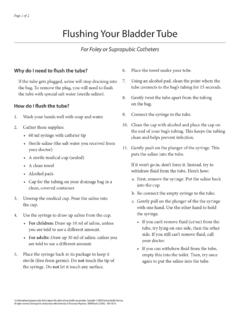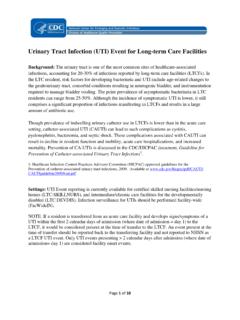Transcription of Autonomic Dysreflexia - msktc.org
1 Autonomic Dysreflexia November 2015 SCI Fact Sheet The Spinal Cord Injury Model System is sponsored by the National Institute of Disability, Independent Living, and Rehabilitation Research, Department of Health and Human Services Administration for Community Living. (See for more information). Autonomic Dysreflexia (AD) is a medical condition that can lead to serious stroke, seizure, organ damage, permanent brain injury, or even death if not treated immediately. This fact sheet will help you better understand AD and prepare you for what to do if you get it. What is Autonomic Dysreflexia ?
2 Autonomic Dysreflexia (AD), sometimes referred to as Autonomic Hyperreflexia, is a potentially life-threatening medical condition that many people with spinal cord injury (SCI) experience when there is a pain or discomfort below their level of injury, even if the pain or discomfort cannot be felt. Am I at risk for AD? People with injury levels at or above T6 are at risk for AD. Read Understanding Spinal Cord Injury Part 1 to learn about levels of injury People with injury levels below T6 may also be at risk for AD in some rare do people with SCI get AD? AD happens because there is a change in the body s Autonomic reflexes after injury.
3 Autonomic Reflexes before SCI The Autonomic nervous system controls body functions like blood pressure, heart rate, body temperature, sweating, digestion, sexual function, and dilation of your eyes pupils through signals sent back and forth from the brain and body through the spinal cord nerves. These functions are largely automatic or involuntary, meaning they are controlled without you thinking about it. There are two main systems within the Autonomic nervous system. Sympathetic nervous system this is the body s involuntary fight or flight response toprepare the body for action when there is some type of stress or threat.
4 Pupils are dilated;the heart rate increases; the heart pumps with more force; and blood vessels get narrowercausing blood pressure to rise. Parasympathetic nervous system this is the rest and digest response. It causesdigestion to improve, the heart to pump more slowly and with less force, and blood vesselsget wider causing blood pressure to body s first reaction to pain or discomfort is to go into the sympathetic, fight or flight mode. However, the brain usually reacts quickly and sends a parasympathetic, rest and digest response to counteract the sympathetic response. This normally creates the balance needed to prevent the body from overre acting to any pain or discomfort and staying in that fight or flight mode.
5 Autonomic Reflexes after SCI Your body s first reaction to pain or discomfort below your injury level is still to go into the sympathetic, fight or flight mode. Your brain then tries to send the parasympathetic, "rest and digest" response to counteract the sympathetic response, but your SCI blocks the signals from reaching the spinal cord below your injury level. The "rest and digest" response only reaches those areas above your injury level, and this allows the fight or flight mode to continue out of control below your injury level. Why is AD life-threatening?AD is life-threatening because blood pressure can rise to dangerous levels when your body stays in that fight or flight mode.
6 Blood Pressure before SCI The heart pumps blood to all parts of the body via blood vessels called arteries. Blood pressure is the force of the blood as it pushes against the walls of the arteries. Blood pressure is always given as two numbers. Systolic (top number) is the pressure in the arteries when the heart squeezes to pump blood. Diastolic (bottom number) is the pressure in the arteries when the heart relaxes. Most people have a normal baseline blood pressure of about 120mmHg80mmHg. Blood pressure changes depending on what a person is doing. For example, blood pressure can be higher during exercise or when a person is in pain.
7 Blood pressure can be lower during rest or sleep. The brain monitors these changes and uses the Autonomic nervous system to keep blood pressure in balance. Blood Pressure after SCI Blood vessels around the bowels, which represent a large portion of the circulatory system that influences overall blood pressure, are controlled by nerve signals below T6. This is why people with injuries at T6 or above have difficulty keeping blood pressure in proper balance. Baseline blood pressure may be lower for some people with SCI, somewhere around the 90 110mmHg50 60mmHg range. AD occurs when a pain or discomfort somewhere below the T6 level of injury causes your systolic blood pressure to rise 20mm to 40mm higher than your normal baseline or your diastolic blood pressure to rise 15mm to 20mm higher than your normal baseline.
8 Your blood pressure will continue to be high until the cause of the pain or discomfort is resolved. If not, the rise in blood pressure can lead to uncontrolled high blood pressure emergencies (hypertensive emergencies). Hemorrhagic stroke (a rupture or leak in a blood vessel in the brain) Organ damage (heart attack, heart failure, kidney failure) Seizures (changes in the brain s electrical activity) Death What can trigger AD? AD can be triggered by anything that might normally cause pain or discomfort below your level of injury even if you cannot feel the pain. Here are the most common areas of concern.
9 Bladder (#1 cause of AD) the bladder is full and needs to be emptied. People who use indwelling ( foley ) catheters, condom catheters (sometimes referred to as sheaths) or suprapubic catheter usually have a kink/blockage of urine flow causing the AD. Bowel constipation, flatus (gas), bowel needs emptying, or hemorrhoids are inflamed. Skin there is a pressure ulcer, pinched skin, cut, ingrown toenail, something too hot or cold touching the skin, or another problem. Broken bone Sexual activity Menstruation (women) What are the symptoms of AD and how do I know if I am having it? The symptoms of AD are caused by the rising blood pressure.
10 Symptoms vary from person to person, and there are some reports of no symptoms but high blood pressure during urination, bowel programs, bladder studies (urodynamics), and sperm retrieval. However, people usually experience one or more symptoms that are fairly easy to recognize. Pounding headache Sweating above the level of injury Slow pulse (although rare, a fast pulse can occur) Goose bumps Skin redness or flushing Nasal congestion Chills without fever Blurred vision Restlessness Cold and clammy skin below the level of injury What do I do if I have AD? Most people with a T6 level of injury or above experience AD after injury.








